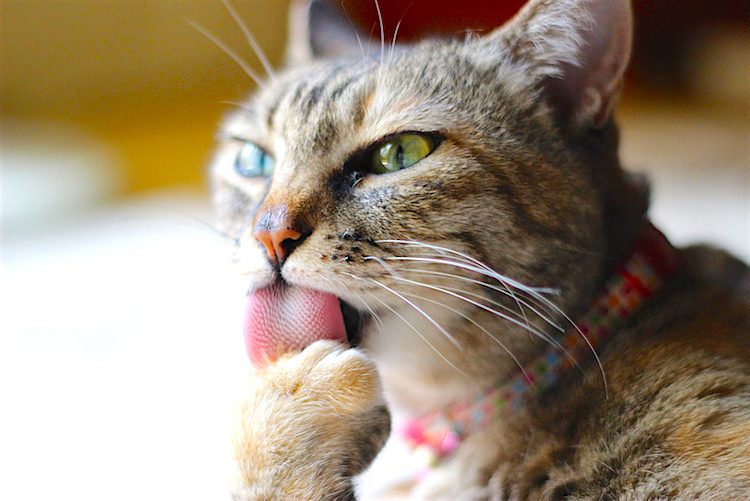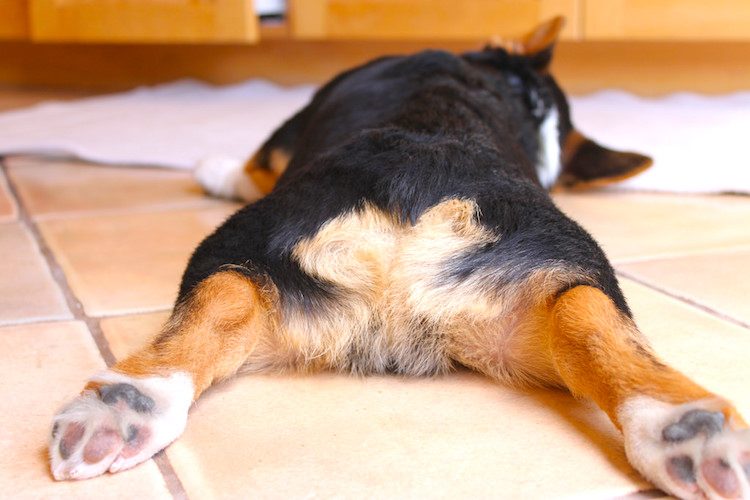[ad_1]
This pet health content was written by a veterinarian, Dr. Pippa Elliott, BVMS, MRCVS. It was last reviewed November 20, 2025.

You know the kind of world where your shoulder bag priorities include pockets for poop bags and dog treats, while your pet-less friend only cares about a designer label swinging from her arm?
In my parallel universe, there are often two names for the same thing. Take “dingleberries” and “pseudocoprostasis” as a classic example. Both mean the same thing, but while you nod knowingly at dingleberries, the word pseudocoprostasis tends to leave people blank-faced.
Such is the clash between veterinary science and sensible English. And sometimes, those worlds collide. I may diagnose pseudocoprostasis without blinking, but a recent client worried about “dingleberries” had me scratching my head.
- Dingleberries are more common than you think: They’re simply feces getting stuck in the fur around your pet’s rear end, especially in long-haired breeds.
- Grooming prevents most problems: Regular brushing and careful trimming around the backside helps stop mats and trapped stool from forming.
- Watch for warning signs: Scooting, bad smells, straining, or not being able to see the anus can all signal a dingleberry issue.
- Seek help when needed: Avoid cutting mats yourself and let a groomer or vet safely remove them, especially if the skin is irritated or infected.
Don’t Guess When It Comes To Your Pet’s Care
Sign up for expert-backed reviews and safety alerts all in one place.

Don’t Guess When It Comes To Your Pet’s Care
Sign up for expert-backed reviews and safety alerts all in one place.
The Meaning of “Dingleberries”
When a client listed “dingleberries” as the reason for a visit, I kept a straight face and waited for clues. My first guess was some sort of skin tag, since those are pretty common in pets. You can learn more about skin tags on dogs here. The real explanation arrived with the dog and the unmistakable smell drifting ahead of him.
What People Think Dingleberries Are vs What They Actually Mean
- Many owners assume the issue is a benign bump or tag
- The reality is far less charming and much more smelly
- Dingleberries are simply feces tangled in the hair around the anus
- Most pet parents use the term because they are not sure what else to call it
When I finally realized what the client meant, the term pseudocoprostasis slipped out of my mouth, which only made things more confusing. If you want the lighthearted version of the definition, you can learn more about dingleberries here.
Dingleberries and Pseudocoprostasis
The two terms often get used interchangeably. Pseudocoprostasis, however, describes a more advanced and uncomfortable situation.
The Difference Between the Two
- Dingleberries involve small bits of stool stuck to nearby fur
- Pseudocoprostasis usually forms a larger, matted fecal plug
- This plug can block the anus and interfere with normal bathroom habits
- Both conditions share a smell that tends to arrive before the pet does
It may be messy, but the good news is that both issues are easy for a groomer or vet to resolve once spotted.
An Extreme Case of Dingleberries
This quickly became my new favorite word, and I admit I used it at every opportunity. The worst case I ever encountered involved a Persian cat who arrived in serious trouble.
How One Milkshake Led to a Major Mess
- The cat had enjoyed a fast-food strawberry milkshake
- The resulting diarrhea tangled into his long trouser hair
- The mess hardened into a large fecal plug
- The cat could no longer defecate and was incredibly uncomfortable
The smell was overpowering, and the owner panicked. He genuinely believed the cat was dying and even dropped him off to be euthanized. Once I followed my nose, the diagnosis of pseudocoprostasis was clear, and the owner finally admitted to the milkshake mishap.
A Very Damp, Very Smelly Save
- The problem was not life threatening
- A full trim and bath were needed to remove the plug
- The cat recovered quickly once cleaned
- Grooming solved what looked like a medical emergency
After one very odorous morning of clipping and bathing, the cat went home to live and snack another day, hopefully not on anything related to ice cream.

How to Avoid Dingleberries
Dingleberries usually show up because of a few simple factors. The good news is that most of them are completely manageable at home.
Why Dingleberries Develop
- Long fur around the rear end
- Upset stomachs
- Lack of grooming
At least two of these three causes are under your control, which makes prevention much easier than cleanup.
If your pet has long or thick fur near their back end, consider giving them the pet version of a bikini trim. Always proceed with care, and you can learn more about why this should be done with great caution in our guide to removing mats from long haired pets. If you are not confident trimming the area without risking the skin, ask a groomer or your local vet tech for help. You can read more about what vet techs do here.
The Role of Regular Grooming
- Matting attracts trapped stool
- Brushing prevents tangles from forming
- Clean, separated fur reduces the chance of buildup
- Routine grooming keeps the coat healthier overall
Make it a habit to comb through the fur regularly. You can see common brushing mistakes and how to avoid them here.
With a bit of maintenance, you can keep your pet’s coat healthy and stop dingleberries before they start.
Signs Your Pet Has Dingleberries
Sometimes dingleberries happen. It is not a catastrophe, but recognizing the issue early helps your pet stay comfortable and prevents bigger problems. Once you spot the signs, you can address the issue before it becomes painful or messy.
Common Signs to Watch For
- The pet constantly turns to chew or lick at the rear end
- A lingering bad smell that follows the pet
- Straining or difficulty passing feces
- Scooting along the floor
- The anus is hidden or not visible under matted fur
If your pet is biting at their rear end or over grooming, you can learn more about why pets bite their fur out here.
Other issues can look similar, especially problems involving the anal sacs. You can learn more about anal sac disorders in cats here.
The Main Giveaway
- If the anus has disappeared under a mat of fur
- If stool cannot pass normally
- If the odor becomes unusually strong
When the anus is no longer visible, dingleberries are usually the culprit rather than a deeper medical issue. A quick check and a bit of cleaning can make a world of difference.
What to Do About Dingleberries
When you discover a dingleberry, resist the urge to rinse it off immediately. Water tends to spread the mess, make it stickier, and turn a small problem into a much larger one.
First Steps for a Cleaner Fix
- Put on latex or disposable gloves
- Use dry paper towels to lift away as much as possible
- Clean gently before bringing any water into the situation
- Bathe the area only after the bulk of the mess is gone
Once you have cleared most of the debris, a gentle wash will help freshen the area and prevent irritation.
Why Scissors Are a Risky Choice
- Mats pull skin into the knot
- Cutting blindly can injure the skin
- Pets may jerk or react suddenly
- Scissors often make the situation more dangerous
You can learn why snipping straight across means lacerating the skin in the Petful guide to safely removing matted fur.
When to Involve a Professional
- A vet or groomer can shave the area safely
- Clippers avoid the risks of hidden skin folds
- Feces against the skin can cause painful sores
- Your pet may need ointment or antibiotics if dermatitis develops
When in doubt, contacting your vet is the safest and most comfortable route for your pet.
Make sure to regularly groom your pet to avoid severe matting, as seen in this video:
Factors Predisposing to Pseudocoprostasis
If the pet has an upset tummy (such as the Persian after drinking a milkshake), this makes soiling more likely. It’s always a good idea to know what your pet is passing, so follow them out into the yard or litter box to see if their poop is normal or not.
Diarrhea can be triggered for all sorts of reasons, including:
- Garbage gut
- Parasites
- Infections
- Dietary allergy
- Sudden change of diet
- Stress
- Medical conditions such as pancreatic enzyme deficiency or inflammatory bowel disease
If your dog is otherwise well and is a known scavenger, then starve them for 24 hours. Allow access to fresh water at all times, then reintroduce a bland diet.
However, if the dog is off-color, vomiting or passing blood, or the problem won’t settle down, then seeing a vet is a must.
So there we have it: the lowdown on dingleberries, or pseudocoprostasis (take your pick). Now back to my parallel universe to see what other surprises the clinic has in store today. I hope life in your parallel universe treats you well. Send me a postcard sometime.
Frequently Asked Questions (FAQ)
What is a dingleberry on a dog?
A dingleberry on a dog is a piece of feces that becomes tangled and stuck in the fur around the dog’s rear end.
How do you deal with dingleberries?
You deal with dingleberries by gently removing the dried stool with dry paper towels, avoiding scissors, and seeking help from a groomer or vet if the area is matted or irritated.
Do cats get dingleberries?
Yes, cats can get dingleberries, especially long haired cats whose fur easily traps stool around the anus.
[ad_2]

